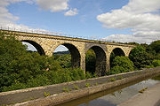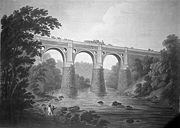
Marple Aqueduct
Encyclopedia
Marple Aqueduct, also known as the Grand Aqueduct, carries the lower level of the Peak Forest Canal
across the River Goyt at Marple, Greater Manchester
, in north-west England
.
Benjamin Outram
and Thomas Brown
jointly designed it and the contract for its construction was placed with William Broadhead, Bethel Furness and William Anderson. The first stone was laid without ceremony in May 1794. The three arches were keyed in during 1799 and it was filled with water in 1800.
 The aqueduct
The aqueduct
contains some 8,000 cubic yards (6,000 m³) of masonry and the arches are semi-circular in form and are on 72 in 4 in (22.05 m) centres. The lower part is of red sandstone, rough hewn from the nearby Hyde Bank quarry
, and the upper part is of white-hewn masonry. The abutments widen in well-proportioned curves and batter or diminish upwards in the same manner. The skilful use of architectural features, such as pierced spandrels and string courses, arch rings and pilasters of ashlar stone, oval piers and stone of different type and colour have created a graceful structure, which is superlative in its class.
Its position, amidst the wooded valley of the river Goyt at Marple, gives it a bold and romantic character. It is a Scheduled Ancient Monument
.
Running along side it to the north is the Marple viaduct, on the Marple, New Mills and Hayfield Railway that services Marple Station
.
Peak Forest Canal
The Peak Forest Canal, is a narrow locked artificial waterway in northern England. It is long and forms part of the connected English/Welsh inland waterway network.-General description:...
across the River Goyt at Marple, Greater Manchester
Marple, Greater Manchester
Marple is a small town within the Metropolitan Borough of Stockport, in Greater Manchester, England. It lies on the River Goyt southeast of Stockport.Historically part of Cheshire, Marple has a population of 23,480 .-Toponymy:...
, in north-west England
England
England is a country that is part of the United Kingdom. It shares land borders with Scotland to the north and Wales to the west; the Irish Sea is to the north west, the Celtic Sea to the south west, with the North Sea to the east and the English Channel to the south separating it from continental...
.
Benjamin Outram
Benjamin Outram
Benjamin Outram was an English civil engineer, surveyor and industrialist. He was a pioneer in the building of canals and tramways.-Personal life:...
and Thomas Brown
Thomas Brown (engineer)
Thomas Brown was an English surveyor, civil engineer, businessman and landowner.Born at Disley in Cheshire, he had interests in coal-mining, particularly in the Haughton and Hyde areas of Greater Manchester, as well as lime burning and mineral extraction interests...
jointly designed it and the contract for its construction was placed with William Broadhead, Bethel Furness and William Anderson. The first stone was laid without ceremony in May 1794. The three arches were keyed in during 1799 and it was filled with water in 1800.

Aqueduct
An aqueduct is a water supply or navigable channel constructed to convey water. In modern engineering, the term is used for any system of pipes, ditches, canals, tunnels, and other structures used for this purpose....
contains some 8,000 cubic yards (6,000 m³) of masonry and the arches are semi-circular in form and are on 72 in 4 in (22.05 m) centres. The lower part is of red sandstone, rough hewn from the nearby Hyde Bank quarry
Quarry
A quarry is a type of open-pit mine from which rock or minerals are extracted. Quarries are generally used for extracting building materials, such as dimension stone, construction aggregate, riprap, sand, and gravel. They are often collocated with concrete and asphalt plants due to the requirement...
, and the upper part is of white-hewn masonry. The abutments widen in well-proportioned curves and batter or diminish upwards in the same manner. The skilful use of architectural features, such as pierced spandrels and string courses, arch rings and pilasters of ashlar stone, oval piers and stone of different type and colour have created a graceful structure, which is superlative in its class.
Its position, amidst the wooded valley of the river Goyt at Marple, gives it a bold and romantic character. It is a Scheduled Ancient Monument
Scheduled Ancient Monument
In the United Kingdom, a scheduled monument is a 'nationally important' archaeological site or historic building, given protection against unauthorized change. The various pieces of legislation used for legally protecting heritage assets from damage and destruction are grouped under the term...
.
Running along side it to the north is the Marple viaduct, on the Marple, New Mills and Hayfield Railway that services Marple Station
Marple railway station
Marple railway station serves Marple, in the Metropolitan Borough of Stockport, Greater Manchester, England. The other station serving Marple is Rose Hill railway station....
.
See also
- List of canal aqueducts in Great Britain
- Scheduled Monuments in Greater ManchesterScheduled Monuments in Greater ManchesterThere are 37 Scheduled Monuments in Greater Manchester, a metropolitan county in North West England. In the United Kingdom, a Scheduled Monument is a "nationally important" archaeological site or historic building that has been given protection against unauthorised change...

